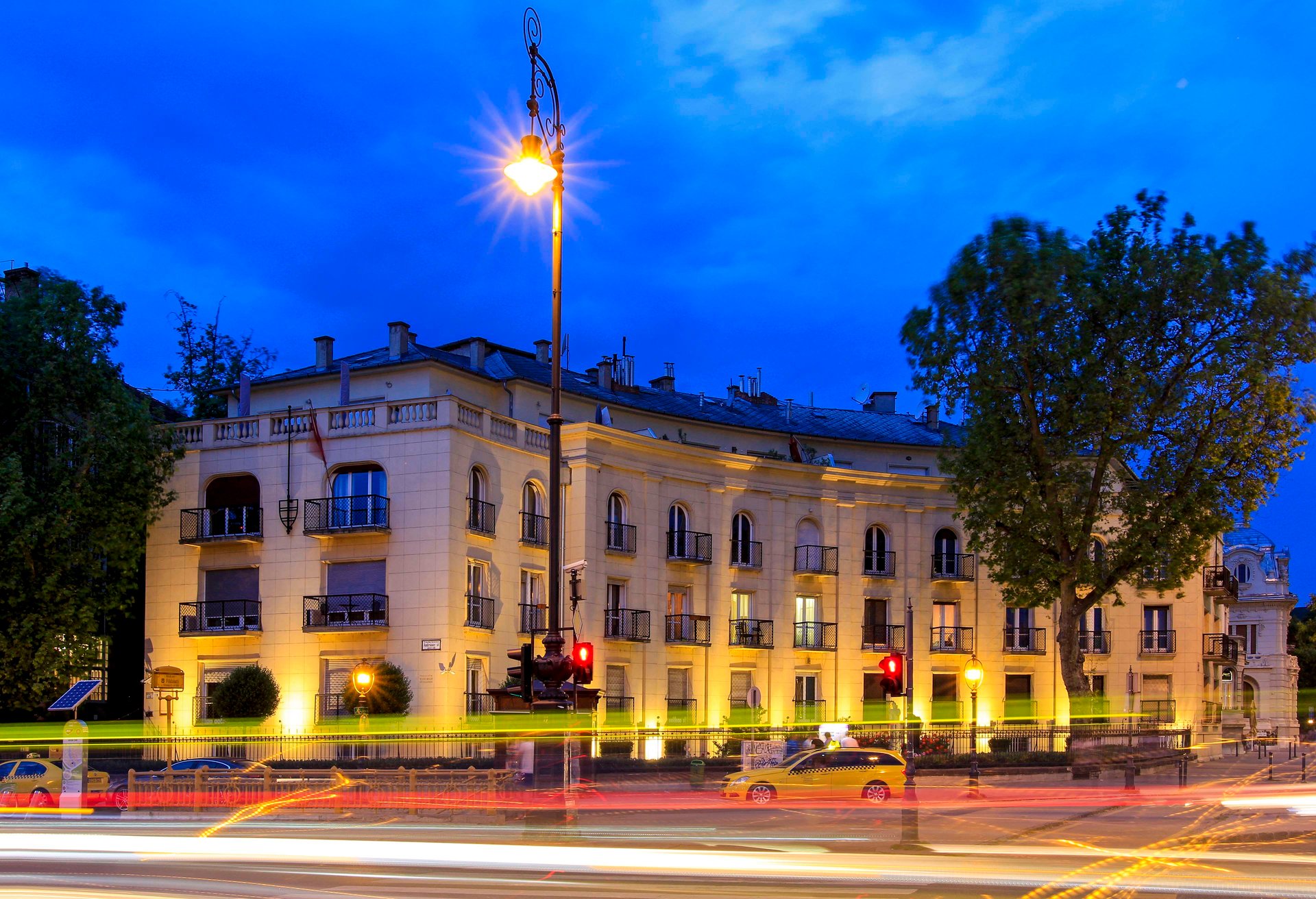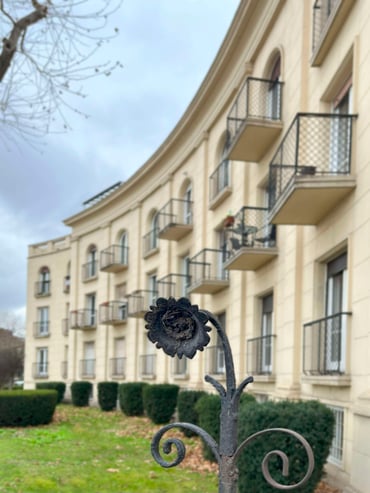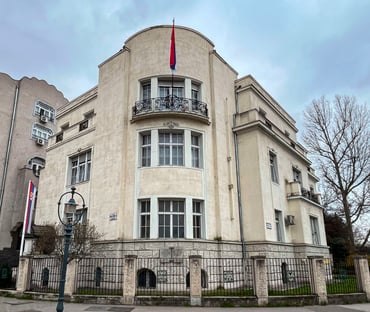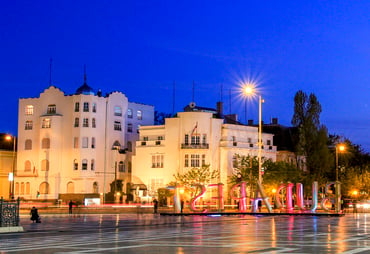-
Necessary cookies help make a website usable by enabling basic functions like page navigation and access to secure areas of the website. The website cannot function properly without these cookies.
- Amazon
6Learn more about this providerauth [x6]Registers whether the user is logged in. This allows the website owner to make parts of the website inaccessible, based on the user's log-in status.
- Cloudflare
1Learn more about this providercf.turnstile.uThis cookie is used to distinguish between humans and bots.
- Cookiebot
4Learn more about this providerCookieConsent [x4]Stores the user's cookie consent state for the current domain
- Cover Manager
1Learn more about this providerdebugThis cookie is used to detect errors on the website - this information is sent to the website's support staff in order to optimize the visitor's experience on the website.
- Google
6Learn more about this provider
Some of the data collected by this provider is for the purposes of personalization and measuring advertising effectiveness.
test_cookieUsed to check if the user's browser supports cookies._GRECAPTCHAThis cookie is used to distinguish between humans and bots. This is beneficial for the website, in order to make valid reports on the use of their website.rc::aThis cookie is used to distinguish between humans and bots. This is beneficial for the website, in order to make valid reports on the use of their website.rc::bThis cookie is used to distinguish between humans and bots.rc::cThis cookie is used to distinguish between humans and bots.rc::fThis cookie is used to distinguish between humans and bots. - Kempinski Hotels
7Learn more about this providercarts-#Voucher Shop - enables storing the selected vouchers in the shopping cart.changedPersonalization-#Voucher Shop - enables adding the personalised message to a voucher.copyPersonalizeVoucher-#Voucher Shop - enables copying the personalised message to other vouchers in the shopping cart.hasSeenFullScreenVideoThis cookie is used to determine if a user has been shown the Kempinski video pop up. Prior to displaying the Cookiebot acceptance banner.payment-#Voucher Shop - initialized payment session details.softTokenThis variable is used to store authorization token of logged out user which Kempinski will use after navigating back to any pages under Kempinski.comcf_chl_rc_niThis cookie is a part of the services provided by Cloudflare - Including load-balancing, deliverance of website content and serving DNS connection for website operators.
- LinkedIn
1Learn more about this providerli_gcStores the user's cookie consent state for the current domain
- Sevenrooms
1Learn more about this providercsrftokenHelps prevent Cross-Site Request Forgery (CSRF) attacks.
- Stripe
15Learn more about this provider__stripe_mid [x7]This cookie is necessary for making credit card transactions on the website. The service is provided by Stripe.com which allows online transactions without storing any credit card information.__stripe_sid [x7]This cookie is necessary for making credit card transactions on the website. The service is provided by Stripe.com which allows online transactions without storing any credit card information.mDetermines the device used to access the website. This allows the website to be formatted accordingly.
- Yandex
2Learn more about this providersync_cookie_csrf [x2]Used in connection with the synchronisation between the website and third-party Data Management Platform. The cookie serves to monitor this process for security reasons.
-
adlonberlin.traumgutscheine.com
kempinskiadriatic.traumgutscheine.com
kempinskiberchtesgaden.traumgutscheine.com
kempinskidastirol.traumgutscheine.com
kempinskidresden.traumgutscheine.com
kempinskiengelberg.traumgutscheine.com
kempinskihightatras.traumgutscheine.com
kempinski-istanbul.traumgutscheine.com
kempinskimalta.traumgutscheine.com
kempinskimunich.traumgutscheine.com
kempinskiportoroz.traumgutscheine.com
kempinski-riga.traumgutscheine.com
12x# [x12]Necessary for the shopping cart functionality on the website. - api.hcaptcha.com
1hmt_idThis cookie is used to distinguish between humans and bots.
- app.tablein.com
1SESS#Preserves users states across page requests.
-
app.tablein.com
backend.app.tablein.com
widget.tablein.com
www.secure-booker.com
8AWSALB [x4]Registers which server-cluster is serving the visitor. This is used in context with load balancing, in order to optimize user experience.AWSALBCORS [x4]Registers which server-cluster is serving the visitor. This is used in context with load balancing, in order to optimize user experience. -
book-widget.pure-informatique.com
www.covermanager.com
2PHPSESSID [x2]Preserves user session state across page requests. - cdn.raygun.io
1raygun4js-useridThis cookie is used to detect errors on the website - this information is sent to the website's support staff in order to optimize the visitor's experience on the website.
-
challenges.cloudflare.com
mindbodyonline.com
2_cfuvid [x2]This cookie is a part of the services provided by Cloudflare - Including load-balancing, deliverance of website content and serving DNS connection for website operators. -
hcaptcha.com
kempinski.com
secure-booker.com
3__cf_bm [x3]This cookie is used to distinguish between humans and bots. This is beneficial for the website, in order to make valid reports on the use of their website. - m.stripe.com
3Learn more about this provider_abThis cookie is necessary for making credit card transactions on the website. The service is provided by Stripe.com which allows online transactions without storing any credit card information._mfThis cookie is necessary for making credit card transactions on the website. The service is provided by Stripe.com which allows online transactions without storing any credit card information.idPending
- mercadopago.com
1_d2idNecessary for the shopping cart functionality on the website.
- thefork.com
1datadomeUsed in context with the website's BotManager. The BotManager detects, categorizes and compiles reports on potential bots trying to access the website.
- titlis1.panocloud.webcam
1isMobileUsed to determine if the desktop or mobile version of the website should be displayed.
- www.secure-booker.com
1ASP.NET_SessionIdPreserves the visitor's session state across page requests.
-
yandex.com
yandex.ru
2i [x2]Preserves users states across page requests.
- Amazon
-
Preference cookies and other tracking tools enable a website to remember information that changes the way the website behaves or looks. They are used to remember your choices and settings, like your language and region, to provide a more personalized experience. This includes saving your last search to help you continue your booking and optimizing your experience through A/B testing
- Amazon
6Learn more about this provideri18n_redirected [x6]Determines the preferred language of the visitor. Allows the website to set the preferred language upon the visitor's re-entry.
- Cookiebot
1Learn more about this providerCookieConsentBulkSetting-#Enables cookie consent across multiple websites
- LinkedIn
1Learn more about this providerlidcRegisters which server-cluster is serving the visitor. This is used in context with load balancing, in order to optimize user experience.
-
b2c.eat2eatmsp.com
b2c.eat2eatmsp.com.cn
b2c.eat2eatmsp.eu
3NEXT_LOCALE [x3]This cookie is used to determine the preferred language of the visitor and sets the language accordingly on the website, if possible.
- Amazon
-
Statistic cookies help website owners to understand how visitors interact with websites by collecting and reporting information anonymously.
- Cover Manager
1Learn more about this providerNRBA_SESSIONCollects data on the user’s navigation and behavior on the website. This is used to compile statistical reports and heatmaps for the website owner.
- Google
42Learn more about this provider
Some of the data collected by this provider is for the purposes of personalization and measuring advertising effectiveness.
_ga [x10]Registers a unique ID that is used to generate statistical data on how the visitor uses the website._ga_# [x10]Used by Google Analytics to collect data on the number of times a user has visited the website as well as dates for the first and most recent visit.__utma [x3]Collects data on the number of times a user has visited the website as well as dates for the first and most recent visit. Used by Google Analytics.__utmb [x3]Registers a timestamp with the exact time of when the user accessed the website. Used by Google Analytics to calculate the duration of a website visit.__utmc [x3]Registers a timestamp with the exact time of when the user leaves the website. Used by Google Analytics to calculate the duration of a website visit.__utmd [x3]This cookie is used to assign specific visitors into segments, this segmentation is based on visitor behavior on the website - the segmentation can be used to target larger groups.__utmv [x3]Saves user-defined tracking parameters for use in Google Analytics.__utmz [x3]Collects data on where the user came from, what search engine was used, what link was clicked and what search term was used. Used by Google Analytics._gid [x4]Registers a unique ID that is used to generate statistical data on how the visitor uses the website. - Kempinski Hotels
2Learn more about this providermapbox.eventData.uuid:#Pendingmapbox.eventData:#Pending
- Microsoft
2Learn more about this provider_clckCollects data on the user’s navigation and behavior on the website. This is used to compile statistical reports and heatmaps for the website owner._clskRegisters statistical data on users' behaviour on the website. Used for internal analytics by the website operator.
- Pixlee
1Learn more about this providerpixlee_analytics_cookie_legacyRegisters if the user has visited or interacted with pages containing pictures or galleries rooting from third-party services. Used to improve website content and make statistical reports for the website.
- TikTok
1Learn more about this provider_tt_enable_cookieUsed by the social networking service, TikTok, for tracking the use of embedded services.
- Yandex
2Learn more about this provider_ym_retryReqsRegisters statistical data on users' behaviour on the website. Used for internal analytics by the website operator._ym3:0_reqNumRegisters statistical data on users' behaviour on the website. Used for internal analytics by the website operator.
-
adlonberlin.traumgutscheine.com
kempinskiadriatic.traumgutscheine.com
kempinskiberchtesgaden.traumgutscheine.com
kempinskidastirol.traumgutscheine.com
kempinskidresden.traumgutscheine.com
kempinskiengelberg.traumgutscheine.com
kempinskihightatras.traumgutscheine.com
kempinski-istanbul.traumgutscheine.com
kempinskimalta.traumgutscheine.com
kempinskimunich.traumgutscheine.com
kempinskiportoroz.traumgutscheine.com
kempinski-riga.traumgutscheine.com
12referrer_url [x12]Detects how the user reached the website by registering their last URL-address. -
assets.pxlecdn.com
assets.pixlee.com
2pixlee_analytics_cookie [x2]Registers if the user has visited or interacted with pages containing pictures or galleries rooting from third-party services. Used to improve website content and make statistical reports for the website. - m.stripe.com
1Learn more about this provider1Registers data on visitors' website-behaviour. This is used for internal analysis and website optimization.
- photos.pixlee.co
1ajs_anonymous_idThis cookie is used to count how many times a website has been visited by different visitors - this is done by assigning the visitor an ID, so the visitor does not get registered twice.
- sc-static.net
2u_scsidRegisters data on visitors' website-behaviour. This is used for internal analysis and website optimization.X-ABThis cookie is used by the website’s operator in context with multi-variate testing. This is a tool used to combine or change content on the website. This allows the website to find the best variation/edition of the site.
- widget.thefork.com
2amp-exp-$default_instance-#This cookie is used by the website’s operator in context with multi-variate testing. This is a tool used to combine or change content on the website. This allows the website to find the best variation/edition of the site.dd_cookie_test_#Registers data on visitors' website-behaviour. This is used for internal analysis and website optimization.
-
yandex.com
yandex.ru
4yandexuid [x2]Registers data on visitors' website-behaviour. This is used for internal analysis and website optimization.ymex [x2]Registers data on visitors' website-behaviour. This is used for internal analysis and website optimization.
- Cover Manager
-
Marketing cookies and other tracking tools are used to track visitors across websites. The intention is to display ads that are relevant and engaging for the individual user and thereby more valuable for publishers and third-party advertisers. We may also use first-party data you provide, such as your email address, to improve the accuracy of our conversion measurement and optimize our advertising campaigns
- Meta Platforms, Inc.
9Learn more about this provider_fbp [x4]Used by Facebook to deliver a series of advertisement products such as real time bidding from third party advertisers.fbssls_#Collects data on the visitor’s use of the comment system on the website, and what blogs/articles the visitor has read. This can be used for marketing purposes.lastExternalReferrerDetects how the user reached the website by registering their last URL-address.lastExternalReferrerTimeDetects how the user reached the website by registering their last URL-address.topicsLastReferenceTimeCollects data on the user across websites - This data is used to make advertisement more relevant.fbsr_#Used to track the user’s interaction with the website’s Facebook chat-widget.
- AdUp Technology
2Learn more about this providersyncDetects whether partner data synchronization is functioning and currently running - This function sends user data between third-party advertisement companies for the purpose of targeted advertisements.sync_secPending
- Adup Technology
3Learn more about this providert/retPendinguidUnique user ID that recognizes the user on returning visitsuid_secCollects data on user behaviour and interaction in order to optimize the website and make advertisement on the website more relevant.
- Google
12Learn more about this provider
Some of the data collected by this provider is for the purposes of personalization and measuring advertising effectiveness.
_gcl_au [x5]Used to measure the efficiency of the website’s advertisement efforts, by collecting data on the conversion rate of the website’s ads across multiple websites.activity#PendingIDEUsed by Google DoubleClick to register and report the website user's actions after viewing or clicking one of the advertiser's ads with the purpose of measuring the efficacy of an ad and to present targeted ads to the user.gmp\conversion#Pendingpagead/1p-conversion/#/Tracks the conversion rate between the user and the advertisement banners on the website - This serves to optimise the relevance of the advertisements on the website.pagead/1p-user-list/#Tracks if the user has shown interest in specific products or events across multiple websites and detects how the user navigates between sites. This is used for measurement of advertisement efforts and facilitates payment of referral-fees between websites.ddm/activity/src=#Pending_gcl_lsTracks the conversion rate between the user and the advertisement banners on the website - This serves to optimise the relevance of the advertisements on the website. - Issuu
1Learn more about this provideriutkRecognises the user's device and what Issuu documents have been read.
- Kempinski Hotels
1Learn more about this providergtm_session_thresholdStores the user's current session state across page views
- LinkedIn
1Learn more about this providerbcookieUsed by the social networking service, LinkedIn, for tracking the use of embedded services.
- Meta Platforms, Inc.
1Learn more about this providerprivacy_sandbox/topics/registration/Pending
- Microsoft
7Learn more about this provider_uetsidUsed to track visitors on multiple websites, in order to present relevant advertisement based on the visitor's preferences._uetsid_expContains the expiry-date for the cookie with corresponding name._uetvidUsed to track visitors on multiple websites, in order to present relevant advertisement based on the visitor's preferences._uetvid_expContains the expiry-date for the cookie with corresponding name.MUIDUsed widely by Microsoft as a unique user ID. The cookie enables user tracking by synchronising the ID across many Microsoft domains._uetsidCollects data on visitor behaviour from multiple websites, in order to present more relevant advertisement - This also allows the website to limit the number of times that they are shown the same advertisement._uetvidUsed to track visitors on multiple websites, in order to present relevant advertisement based on the visitor's preferences.
- Pinterest
3Learn more about this provider_pinterest_ct_uaUsed by Pinterest to track the usage of services.ar_debugChecks whether a technical debugger-cookie is present.v3/Used by Pinterest to track the usage of services.
- TikTok
6Learn more about this providertt_appInfoUsed by the social networking service, TikTok, for tracking the use of embedded services.tt_pixel_session_indexUsed by the social networking service, TikTok, for tracking the use of embedded services.tt_sessionIdUsed by the social networking service, TikTok, for tracking the use of embedded services._ttp [x2]Used by the social networking service, TikTok, for tracking the use of embedded services.ttcsidUsed to track visitors on multiple websites, in order to present relevant advertisement based on the visitor's preferences.
- Travel Audience
2Learn more about this provider_tracker [x2]Sets a unique ID for the visitor, that allows third party advertisers to target the visitor with relevant advertisement. This pairing service is provided by third party advertisement hubs, which facilitates real-time bidding for advertisers.
- Yandex
12Learn more about this provider_ym_dContains the date of the visitor's first visit to the website._ym_isadThis cookie is used to determine if the visitor has any adblocker software in their browser – this information can be used to make website content inaccessible to visitors if the website is financed with third-party advertisement._ym_uidThis cookie is used to collect non-personal information on the visitor's website behavior and non-personal visitor statistics.metrika_enabledUsed to track visitors on multiple websites, in order to present relevant advertisement based on the visitor's preferences.sync_cookie_image_decideUsed for data-synchronization with advertisement networks.sync_cookie_okUsed for data-synchronization with advertisement networks.yabs-sid [x2]Registers data on visitors from multiple visits and on multiple websites. This information is used to measure the efficiency of advertisement on websites._ym#_lsidPending_ym_syncedTracks the user’s interaction with the website’s search-bar-function. This data can be used to present the user with relevant products or services._ym_uidCollects data on the user’s navigation and behavior on the website. This is used to compile statistical reports and heatmaps for the website owner.sync_cookie_image_finishUsed for data-synchronization with advertisement networks.
- sc-static.net
7_schn1Sets a unique ID for the visitor, that allows third party advertisers to target the visitor with relevant advertisement. This pairing service is provided by third party advertisement hubs, which facilitates real-time bidding for advertisers._scidSets a unique ID for the visitor, that allows third party advertisers to target the visitor with relevant advertisement. This pairing service is provided by third party advertisement hubs, which facilitates real-time bidding for advertisers._scid_rSets a unique ID for the visitor, that allows third party advertisers to target the visitor with relevant advertisement. This pairing service is provided by third party advertisement hubs, which facilitates real-time bidding for advertisers._screloadUsed by Snapchat to implement advertisement content on the website - The cookie detects the efficiency of the ads and collects visitor data for further visitor segmentation.u_sclidSets a unique ID for the visitor, that allows third party advertisers to target the visitor with relevant advertisement. This pairing service is provided by third party advertisement hubs, which facilitates real-time bidding for advertisers.u_sclid_rSets a unique ID for the visitor, that allows third party advertisers to target the visitor with relevant advertisement. This pairing service is provided by third party advertisement hubs, which facilitates real-time bidding for advertisers.u_scsid_rSets a unique ID for the visitor, that allows third party advertisers to target the visitor with relevant advertisement. This pairing service is provided by third party advertisement hubs, which facilitates real-time bidding for advertisers.
-
yandex.com
yandex.ru
6_yasc [x2]Collects data on the user across websites - This data is used to make advertisement more relevant.bh [x2]Collects data on user behaviour and interaction in order to optimize the website and make advertisement on the website more relevant.yuidss [x2]Collects data on visitor behaviour from multiple websites, in order to present more relevant advertisement - This also allows the website to limit the number of times that they are shown the same advertisement.
- Meta Platforms, Inc.
-
Unclassified cookies are cookies that we are in the process of classifying, together with the providers of individual cookies.
- Amazon
1Learn more about this providernuxt-color-modePending
- Google
43Learn more about this provider
Some of the data collected by this provider is for the purposes of personalization and measuring advertising effectiveness.
ddm/fls/z/src=13239125;dc_pre=CIej4JXEopEDFddmHgIdW081qA;type=kempi0;cat=lvkpi0;dc_lat=;dc_rdid=;tag_for_child_directed_treatment=;tfua=;npa=;gdpr=$%7BGDPR%7D;gdpr_consent=$%7BGDPR_CONSENT_755%7D;ord=791399396Pendingddm/fls/z/src=13239125;dc_pre=CIfB75fEopEDFdN7HgIdyboY_g;type=kempi0;cat=lvkpi0;dc_lat=;dc_rdid=;tag_for_child_directed_treatment=;tfua=;npa=;gdpr=$%7BGDPR%7D;gdpr_consent=$%7BGDPR_CONSENT_755%7D;ord=935857351Pendingddm/fls/z/src=13239125;dc_pre=CIG9gMvEopEDFVpTHgIdavkM-A;type=kempi0;cat=lvkpi0;dc_lat=;dc_rdid=;tag_for_child_directed_treatment=;tfua=;npa=;gdpr=$%7BGDPR%7D;gdpr_consent=$%7BGDPR_CONSENT_755%7D;ord=682066296Pendingddm/fls/z/src=13239125;dc_pre=CIjTsYvEopEDFRVvHgIdjD48Lw;type=kempi0;cat=lvkpi0;dc_lat=;dc_rdid=;tag_for_child_directed_treatment=;tfua=;npa=;gdpr=$%7BGDPR%7D;gdpr_consent=$%7BGDPR_CONSENT_755%7D;ord=1685999771Pendingddm/fls/z/src=13239125;dc_pre=CILMnsLEopEDFfphHgIdlT0umg;type=kempi0;cat=lvkpi0;dc_lat=;dc_rdid=;tag_for_child_directed_treatment=;tfua=;npa=;gdpr=$%7BGDPR%7D;gdpr_consent=$%7BGDPR_CONSENT_755%7D;ord=388314430Pendingddm/fls/z/src=13239125;dc_pre=CIqz3qTEopEDFa5iHgId8xcJmw;type=kempi0;cat=lvkpi0;dc_lat=;dc_rdid=;tag_for_child_directed_treatment=;tfua=;npa=;gdpr=$%7BGDPR%7D;gdpr_consent=$%7BGDPR_CONSENT_755%7D;ord=222454587Pendingddm/fls/z/src=13239125;dc_pre=CJ26wZDEopEDFbRIHgIdmycSug;type=kempi0;cat=lvkpi0;dc_lat=;dc_rdid=;tag_for_child_directed_treatment=;tfua=;npa=;gdpr=$%7BGDPR%7D;gdpr_consent=$%7BGDPR_CONSENT_755%7D;ord=668789210Pendingddm/fls/z/src=13239125;dc_pre=CJDMopLEopEDFcxIHgIdjCwNMg;type=kempi0;cat=lvkpi0;dc_lat=;dc_rdid=;tag_for_child_directed_treatment=;tfua=;npa=;gdpr=$%7BGDPR%7D;gdpr_consent=$%7BGDPR_CONSENT_755%7D;ord=1687028610Pendingddm/fls/z/src=13239125;dc_pre=CJrnrbvEopEDFY1bHgIdALocLg;type=kempi0;cat=lvkpi0;dc_lat=;dc_rdid=;tag_for_child_directed_treatment=;tfua=;npa=;gdpr=$%7BGDPR%7D;gdpr_consent=$%7BGDPR_CONSENT_755%7D;ord=207732881Pendingddm/fls/z/src=13239125;dc_pre=CKeu-IrEopEDFSNYHgIdK1sqWA;type=kempi0;cat=lvkpi0;dc_lat=;dc_rdid=;tag_for_child_directed_treatment=;tfua=;npa=;gdpr=$%7BGDPR%7D;gdpr_consent=$%7BGDPR_CONSENT_755%7D;ord=1000435749Pendingddm/fls/z/src=13239125;dc_pre=CKGV0JLEopEDFY1bHgIdALocLg;type=kempi0;cat=lvkpi0;dc_lat=;dc_rdid=;tag_for_child_directed_treatment=;tfua=;npa=;gdpr=$%7BGDPR%7D;gdpr_consent=$%7BGDPR_CONSENT_755%7D;ord=1215886920Pendingddm/fls/z/src=13239125;dc_pre=CKig15TEopEDFQVZHgId8xI4nA;type=kempi0;cat=lvkpi0;dc_lat=;dc_rdid=;tag_for_child_directed_treatment=;tfua=;npa=;gdpr=$%7BGDPR%7D;gdpr_consent=$%7BGDPR_CONSENT_755%7D;ord=1619561763Pendingddm/fls/z/src=13239125;dc_pre=CKP8843EopEDFeZSHgIdJ7IoqQ;type=kempi0;cat=lvkpi0;dc_lat=;dc_rdid=;tag_for_child_directed_treatment=;tfua=;npa=;gdpr=$%7BGDPR%7D;gdpr_consent=$%7BGDPR_CONSENT_755%7D;ord=1265800921Pendingddm/fls/z/src=13239125;dc_pre=CKT1uZzEopEDFdJeHgId3FUnMQ;type=kempi0;cat=lvkpi0;dc_lat=;dc_rdid=;tag_for_child_directed_treatment=;tfua=;npa=;gdpr=$%7BGDPR%7D;gdpr_consent=$%7BGDPR_CONSENT_755%7D;ord=496262836Pendingddm/fls/z/src=13239125;dc_pre=CKvg-o_EopEDFfRjHgId44QXpQ;type=kempi0;cat=lvkpi0;dc_lat=;dc_rdid=;tag_for_child_directed_treatment=;tfua=;npa=;gdpr=$%7BGDPR%7D;gdpr_consent=$%7BGDPR_CONSENT_755%7D;ord=363902081Pendingddm/fls/z/src=13239125;dc_pre=CL37vpLEopEDFVtkHgIdoX8VmQ;type=kempi0;cat=lvkpi0;dc_lat=;dc_rdid=;tag_for_child_directed_treatment=;tfua=;npa=;gdpr=$%7BGDPR%7D;gdpr_consent=$%7BGDPR_CONSENT_755%7D;ord=1220821238Pendingddm/fls/z/src=13239125;dc_pre=CL6wvL3EopEDFRxeHgIdUP4XnA;type=kempi0;cat=lvkpi0;dc_lat=;dc_rdid=;tag_for_child_directed_treatment=;tfua=;npa=;gdpr=$%7BGDPR%7D;gdpr_consent=$%7BGDPR_CONSENT_755%7D;ord=2134896262Pendingddm/fls/z/src=13239125;dc_pre=CLaxzYvEopEDFTtOHgIdsDQS-g;type=kempi0;cat=lvkpi0;dc_lat=;dc_rdid=;tag_for_child_directed_treatment=;tfua=;npa=;gdpr=$%7BGDPR%7D;gdpr_consent=$%7BGDPR_CONSENT_755%7D;ord=2071193582Pendingddm/fls/z/src=13239125;dc_pre=CLmtiJHEopEDFfRbHgIdHT4bqA;type=kempi0;cat=lvkpi0;dc_lat=;dc_rdid=;tag_for_child_directed_treatment=;tfua=;npa=;gdpr=$%7BGDPR%7D;gdpr_consent=$%7BGDPR_CONSENT_755%7D;ord=1268489370Pendingddm/fls/z/src=13239125;dc_pre=CLSg8IrEopEDFdZaHgIdWFYZNQ;type=kempi0;cat=lvkpi0;dc_lat=;dc_rdid=;tag_for_child_directed_treatment=;tfua=;npa=;gdpr=$%7BGDPR%7D;gdpr_consent=$%7BGDPR_CONSENT_755%7D;ord=497708250Pendingddm/fls/z/src=13239125;dc_pre=CLvCs9LEopEDFUBdHgIdFjAAMQ;type=kempi0;cat=lvkpi0;dc_lat=;dc_rdid=;tag_for_child_directed_treatment=;tfua=;npa=;gdpr=$%7BGDPR%7D;gdpr_consent=$%7BGDPR_CONSENT_755%7D;ord=1889766090Pendingddm/fls/z/src=13239125;dc_pre=CMb5kMXEopEDFdN7HgIdyboY_g;type=kempi0;cat=lvkpi0;dc_lat=;dc_rdid=;tag_for_child_directed_treatment=;tfua=;npa=;gdpr=$%7BGDPR%7D;gdpr_consent=$%7BGDPR_CONSENT_755%7D;ord=2098012907Pendingddm/fls/z/src=13239125;dc_pre=CMfw1r_EopEDFQBpHgIdZ1g0dg;type=kempi0;cat=lvkpi0;dc_lat=;dc_rdid=;tag_for_child_directed_treatment=;tfua=;npa=;gdpr=$%7BGDPR%7D;gdpr_consent=$%7BGDPR_CONSENT_755%7D;ord=92367235Pendingddm/fls/z/src=13239125;dc_pre=CM-IiZXEopEDFVtAHgIdWd4O-g;type=kempi0;cat=lvkpi0;dc_lat=;dc_rdid=;tag_for_child_directed_treatment=;tfua=;npa=;gdpr=$%7BGDPR%7D;gdpr_consent=$%7BGDPR_CONSENT_755%7D;ord=1804909203Pendingddm/fls/z/src=13239125;dc_pre=CMmowI3EopEDFVtZHgIdBQkJWw;type=kempi0;cat=lvkpi0;dc_lat=;dc_rdid=;tag_for_child_directed_treatment=;tfua=;npa=;gdpr=$%7BGDPR%7D;gdpr_consent=$%7BGDPR_CONSENT_755%7D;ord=1457838333Pendingddm/fls/z/src=13239125;dc_pre=CN_kiaHEopEDFUhoHgId-9Ic4Q;type=kempi0;cat=lvkpi0;dc_lat=;dc_rdid=;tag_for_child_directed_treatment=;tfua=;npa=;gdpr=$%7BGDPR%7D;gdpr_consent=$%7BGDPR_CONSENT_755%7D;ord=1241862829Pendingddm/fls/z/src=13239125;dc_pre=CNaB8sTEopEDFaBgHgIdf0ky_w;type=kempi0;cat=lvkpi0;dc_lat=;dc_rdid=;tag_for_child_directed_treatment=;tfua=;npa=;gdpr=$%7BGDPR%7D;gdpr_consent=$%7BGDPR_CONSENT_755%7D;ord=1628968205Pendingddm/fls/z/src=13239125;dc_pre=CNOJzsLEopEDFUFOHgIdauILsw;type=kempi0;cat=lvkpi0;dc_lat=;dc_rdid=;tag_for_child_directed_treatment=;tfua=;npa=;gdpr=$%7BGDPR%7D;gdpr_consent=$%7BGDPR_CONSENT_755%7D;ord=1050889317Pendingddm/fls/z/src=13239125;dc_pre=CNrqu5fEopEDFVlYHgIdJJ8zMg;type=kempi0;cat=lvkpi0;dc_lat=;dc_rdid=;tag_for_child_directed_treatment=;tfua=;npa=;gdpr=$%7BGDPR%7D;gdpr_consent=$%7BGDPR_CONSENT_755%7D;ord=1609677406Pendingddm/fls/z/src=13239125;dc_pre=CNTi-M_EopEDFXhXHgIdlCo76Q;type=kempi0;cat=lvkpi0;dc_lat=;dc_rdid=;tag_for_child_directed_treatment=;tfua=;npa=;gdpr=$%7BGDPR%7D;gdpr_consent=$%7BGDPR_CONSENT_755%7D;ord=905817220Pendingddm/fls/z/src=13239125;dc_pre=CNXW84rEopEDFR9cHgIdiNoonw;type=kempi0;cat=lvkpi0;dc_lat=;dc_rdid=;tag_for_child_directed_treatment=;tfua=;npa=;gdpr=$%7BGDPR%7D;gdpr_consent=$%7BGDPR_CONSENT_755%7D;ord=414107905Pendingddm/fls/z/src=13239125;dc_pre=CO_Dk5rEopEDFZNOHgIdOiEE9w;type=kempi0;cat=lvkpi0;dc_lat=;dc_rdid=;tag_for_child_directed_treatment=;tfua=;npa=;gdpr=$%7BGDPR%7D;gdpr_consent=$%7BGDPR_CONSENT_755%7D;ord=732739279Pendingddm/fls/z/src=13239125;dc_pre=CO-0hpjEopEDFZFDHgIddxAIJA;type=kempi0;cat=lvkpi0;dc_lat=;dc_rdid=;tag_for_child_directed_treatment=;tfua=;npa=;gdpr=$%7BGDPR%7D;gdpr_consent=$%7BGDPR_CONSENT_755%7D;ord=1792779642Pendingddm/fls/z/src=13239125;dc_pre=COb2yMjEopEDFV1XHgId0lIfTQ;type=kempi0;cat=lvkpi0;dc_lat=;dc_rdid=;tag_for_child_directed_treatment=;tfua=;npa=;gdpr=$%7BGDPR%7D;gdpr_consent=$%7BGDPR_CONSENT_755%7D;ord=1125016681Pendingddm/fls/z/src=13239125;dc_pre=COCH9pLEopEDFctfHgId_GU9ng;type=kempi0;cat=lvkpi0;dc_lat=;dc_rdid=;tag_for_child_directed_treatment=;tfua=;npa=;gdpr=$%7BGDPR%7D;gdpr_consent=$%7BGDPR_CONSENT_755%7D;ord=1705714017Pendingddm/fls/z/src=13239125;dc_pre=COniqo_EopEDFQVZHgId8xI4nA;type=kempi0;cat=lvkpi0;dc_lat=;dc_rdid=;tag_for_child_directed_treatment=;tfua=;npa=;gdpr=$%7BGDPR%7D;gdpr_consent=$%7BGDPR_CONSENT_755%7D;ord=2142107167Pendingddm/fls/z/src=13239125;dc_pre=COPK5pjEopEDFURXHgIdVvYIXQ;type=kempi0;cat=lvkpi0;dc_lat=;dc_rdid=;tag_for_child_directed_treatment=;tfua=;npa=;gdpr=$%7BGDPR%7D;gdpr_consent=$%7BGDPR_CONSENT_755%7D;ord=73739153Pendingddm/fls/z/src=13239125;dc_pre=COTVuo7EopEDFXtEHgIddwsuLQ;type=kempi0;cat=lvkpi0;dc_lat=;dc_rdid=;tag_for_child_directed_treatment=;tfua=;npa=;gdpr=$%7BGDPR%7D;gdpr_consent=$%7BGDPR_CONSENT_755%7D;ord=64741540Pendingddm/fls/z/src=13239125;dc_pre=COuw5o3EopEDFURXHgIdVvYIXQ;type=kempi0;cat=lvkpi0;dc_lat=;dc_rdid=;tag_for_child_directed_treatment=;tfua=;npa=;gdpr=$%7BGDPR%7D;gdpr_consent=$%7BGDPR_CONSENT_755%7D;ord=5134069Pendingddm/fls/z/src=13239125;dc_pre=COz7m5XEopEDFXJgHgIdPwYgKw;type=kempi0;cat=lvkpi0;dc_lat=;dc_rdid=;tag_for_child_directed_treatment=;tfua=;npa=;gdpr=$%7BGDPR%7D;gdpr_consent=$%7BGDPR_CONSENT_755%7D;ord=1676170911Pendingddm/fls/z/src=13239125;dc_pre=CP_N35fEopEDFXNaHgIda84fWw;type=kempi0;cat=lvkpi0;dc_lat=;dc_rdid=;tag_for_child_directed_treatment=;tfua=;npa=;gdpr=$%7BGDPR%7D;gdpr_consent=$%7BGDPR_CONSENT_755%7D;ord=1066492856Pendingddm/fls/z/src=13239125;dc_pre=CPGKtJXEopEDFWlXHgId0IEQLQ;type=kempi0;cat=lvkpi0;dc_lat=;dc_rdid=;tag_for_child_directed_treatment=;tfua=;npa=;gdpr=$%7BGDPR%7D;gdpr_consent=$%7BGDPR_CONSENT_755%7D;ord=1015464061Pendingddm/fls/z/src=13239125;dc_pre=CPSN5ZPEopEDFcdYHgId4B0s-A;type=kempi0;cat=lvkpi0;dc_lat=;dc_rdid=;tag_for_child_directed_treatment=;tfua=;npa=;gdpr=$%7BGDPR%7D;gdpr_consent=$%7BGDPR_CONSENT_755%7D;ord=737042188Pending - Issuu
15Learn more about this providerfirstSessionTimestampPendingisFirstSessionPendingLOCAL_STORAGE_ID_pico_lsidPendingorionV3#identityPendingpico#eventsPendingpico#keyvalPendingPICOX_PINGPendingSESSION_STORAGE_ID_pico_lsidPendingSESSION_STORAGE_ID_pico_ssidPendingSESSION_STORAGE_ID_PICOX_SESSION_IDPendingspidersense#eventPendingspidersense#setup_responsePendingspidersense#user_infoPendingspidersense:user_id:v1_issuu_webPendingCOOKIE_ID_pico_lsidPending
- Kempinski Hotels
10Learn more about this providergtmAdUpTriggeredPendinggtmHasSeenPixleeWidgetPendingGB_lastSessionUrlsPendingGB_previousSessionUrlsPendinggb_session_countPendinggb_session_flagPendingGB_sessionActivePendingL2N1cnJlbmN5L3JhdGVzPendingL2xvY2F0aW9uL21lPendingstayPending
- Menumodo
1Learn more about this provider__Secure-cisessionPending
- Mindbody Business
2Learn more about this providerSD_SIDPendingSD_SID_TIMEPending
- Sevenrooms
1Learn more about this providerG_AUTH2_MIGRATIONPending
- TikTok
1Learn more about this providerttcsid_CR65HHBC77U5L7EOOUG0Pending
- Travel Audience
2Learn more about this providergoogle_match.ashxPendingtrg.gifPending
- adlonberlin.traumgutscheine.com
1kab_iframePending
- kempinski-ac.onrender.com
1hasVisitedKempinskiPending
- kempinski-istanbul.traumgutscheine.com
1kib_iframePending
- kempinski-riga.traumgutscheine.com
1kra_iframePending
- kempinskiadriatic.traumgutscheine.com
1ski_iframePending
- kempinskiberchtesgaden.traumgutscheine.com
1khb_iframePending
- kempinskidastirol.traumgutscheine.com
1kdt_iframePending
- kempinskidresden.traumgutscheine.com
1khd_iframePending
- kempinskiengelberg.traumgutscheine.com
1kpe_iframePending
- kempinskihightatras.traumgutscheine.com
1kht_iframePending
- kempinskimalta.traumgutscheine.com
1khm_iframePending
- kempinskimunich.traumgutscheine.com
1khj_iframePending
- kempinskiportoroz.traumgutscheine.com
1pap_iframePending
- kempinskithespabudapest.book.app
1ovatu_sessionPending
- panocloud.webcam
1FRONTENDSESSIDPending
- sc-static.net
1_ScCbtsPending
- titlis1.panocloud.webcam
1vIDPending
- widget.thefork.com
1EXP_client-ysQ_DEFAULT_USER_PROVIDERPending
- www.concilio.store
3domainPendingidentifierPendingnewUrlPending
- www.eat2eat.com
1SWBooking/Pages/ImageHandler.ashxPending
- Amazon
Cookies are small text files that can be used by websites to make a user's experience more efficient.
The law states that we can store cookies on your device if they are strictly necessary for the operation of this site. For all other types of cookies we need your permission.
This site uses different types of cookies. Some cookies are placed by third party services that appear on our pages.
You can at any time change or withdraw your consent from the Cookie Declaration on our website.
Learn more about who we are, how you can contact us and how we process personal data in our Privacy Policy.
Please state your consent ID and date when you contact us regarding your consent.



